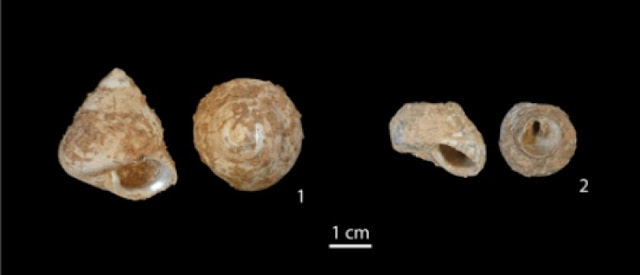
New high precision radiocarbon dates of mollusk shells show that modern humans occupied the Near East at least 45,900 years ago and colonized Europe from there.
A multinational team, which included researchers from the University of York, analysed shells recovered at Ksâr ‘Akil, a site in Lebanon. Ksâr ‘Akil is one of the few sites in the Near East where modern human fossils are associated with Upper Palaeolithic (UP) tools.
The researchers radiocarbon-dated the shell carbonates of the mollusck species Phorcus turbinatus that was eaten by prehistoric humans. The analysis revealed that modern humans carrying UP tools occupied the eastern Mediterranean at least 45,900 years ago. This confirms UP modern human presence in the Levant prior to their arrival in Europe and suggests that it served as a corridor for the colonization of Europe by modern humans.
Dr Beatrice Demarchi, of the Department of Archaeology at York, and Sheila Taylor, of the University’s Department of Chemistry, were part of the team which studied around 3500 shells comprising 49 species. The researchers found that the best-preserved shells were those of mollusks gathered by prehistoric humans for consumption as food and they used new techniques to ensure that the samples had not been compromised during burial before radiocarbon dating them.
“One of these approaches is a technique called ‘intra-crystalline protein diagenesis’ which evaluates the integrity of amino acids preserved in the intra-crystalline structure of the shell carbonates” says Dr Demarchi. Amino acid analyses were undertaken at the University’s Natural Environment Research Council-recognised facility for amino acid analysis.
The study, which is published in Proceedings of the National Academy of Sciences (PNAS), has allowed the researchers to propose a robust new chronology for Ksâr ‘Akil. Their results confirm the presence of modern humans carrying a UP toolkit in the Levant prior to any modern human fossils in Europe.
The timing of the spread of modern humans out of Africa and into Eurasia is a topic of major debate among archaeologists, human paleontologists and geneticists. They have been seeking to establish when modern humans first arrived in Europe, the route they took and if the Levant serve as a corridor facilitating Upper Palaeolithic modern human dispersal.
The importance of Ksâr ‘Akil lies in the fact that there are two modern human fossils, nicknamed ‘Ethelruda’ and ‘Egbert’ by the original excavators, associated with Upper Palaeolithic toolkits from the site.
However, the new research shows that Egbert lived around 43,000 years ago and Ethelruda at least 45,900 years ago, possibly earlier. Therefore, Ethelruda pre-dates all European modern humans.
Marjolein Bosch, from the Max Planck Institute for Evolutionary Anthropology, the lead author of the study added: “Toolkits similar to those associated with Ethelruda and Egbert are also found in other sites in the Levant as well as in Europe. These similar toolkits and the earlier ages in the Near East suggest population dispersals from the Near East to Europe between 55,000 and 40,000 years ago.”
Reference:
Marjolein D. Bosch, Marcello A. Mannino, Amy L. Prendergast, Tamsin C. O’Connell, Beatrice Demarchi, Sheila M. Taylor, Laura Niven, Johannes van der Plicht, and Jean-Jacques Hublin. New chronology for Ksâr ‘Akil (Lebanon) supports Levantine route of modern human dispersal into Europe. Proceedings of the National Academy of Sciences, 2015; DOI: 10.1073/pnas.1501529112
Note: The above story is based on materials provided by University of York.










